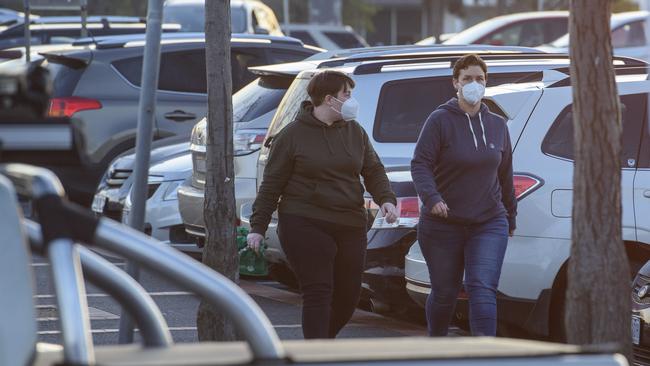
But State Street Global Advisors cautions that the risk appetite will eventually be tested by further turmoil related to the pandemic, against a backdrop of fiscal, economic and political volatility.
Some positives remain, including a return to growth at the end of 2020, as well as increasingly hopeful prospects for a scalable vaccine and the eventual reopening of global economies.
But even with the promise of a vaccine, an uncertain horizon remains as policymakers try to wean economies off the monetary and fiscal stimulus that has sustained markets, according to State Street’s asset management arm.
SSGA managers $US3.05 trillion ($4.1 trillion) of assets for investors globally.
It favours growth and quality assets — particularly in the US and China — rather than the value exposures globally that have done well in recent months, particularly since the US election.
“While we are very comfortable with our expectations for a strong economic rebound in 2021, we are increasingly focusing our sights on everything that comes after that surge,” SSGA’s global chief investment officer Rick Lacaille said in the fund manager’s Global Markets Outlook.
“A combination of alertness and agility is most likely to reward investors, as recession gives way to a powerful but temporary rebound, followed by an as-yet-undecided new baseline of growth.”
The view is that the global economy has transitioned from the injection of monetary and fiscal stimulus following the pandemic, to economic reopening — with governments mostly implementing fewer onerous restrictions — allowing the global economy to operate at a comparatively higher level.

But while short-term market buoyancy is likely as economies open fully and restrictions on movement are lifted amid vaccinations, the longer-term outlook is less certain.
“At some point, economies will need to transition back to autonomous growth, independent of monetary and fiscal stimulus,” SSGA Deputy Global Chief Investment Officer Lori Heinel said.
“How perfect or how imperfect a substitution growth will be for stimulus remains to be seen. The adjustment will be complex, and it is very likely to cause some market convulsions.”
Despite these challenges, investors will see selective opportunities next year.
While China was the first nation to see COVID cases, its strict and far-reaching control measures soon contained the virus, allowing the recovery process to continue largely uninterrupted.
“China will be the only large economy to see positive GDP growth in 2020, about 2.5 per cent, but this should be tempered with a note of caution given high debt levels, deteriorating demographics and ongoing geopolitical tensions,” Kevin Anderson, SSGA’s head of investments, APAC, said.
China’s corporate earnings should be resilient particularly in growth and consumer stocks.
Its fixed income assets are very attractive based on their yield and potential currency appreciation.
The US meanwhile is forecast to face less contraction than many other developed economies — about 3.7 per cent versus more acute declines of 9 per cent in Britain and 7 per cent in the EU.
Joe Biden’s recent election win has sparked speculation on the scale, timing and characteristics of further stimulus packages and SSGA’s outlook is for a “smaller-but-sooner” support package, somewhere between the $US0.5 trillion proposed by Senate Majority Leader Mitch McConnell and the $US2.2 trillion proposal from Speaker Nancy Pelosi.
Anything more could trigger further questions about the potential for rising inflation.
Beyond the US and China, the wider global picture is mixed.
Britain looks like a notable underperformer after contracting 11 per cent year-on-year in the first three quarters of 2020, compared to 5.9 per cent for the German economy over the same period.
With a comparatively lacklustre response to the COVID-19 outbreak and the increasing risk of a “no-deal” Brexit, Britain faces unfavourable circumstances for near-term economic performance.
Meanwhile the EU, which faces enhanced COVID-related restrictions, has deployed a cohesive and supportive macro policy response to the pandemic, according to SSGA.
A fourth-quarter contraction is expected, but the fund manager sees a sufficiently counter-cyclical fiscal policy can help combat internal frictions and troublesome institutional limitations to growth in 2021.
Emerging markets face more varied outcomes, but vaccines may deliver disproportionate gains given the EMs dependence on exports generally and commodities in particular.
SSGA’s head of investments in Australia, Jonathan Shead, argues that most of the upside for markets next year will have to come from earnings growth rather than price-to-earnings multiple expansion, given the extent to which prices have run ahead of earnings and dividends this year.
But with central banks likely to remain cautious about removing stimulus while the pandemic still has potential to re-escalate, there is something of a sweet spot for markets in the short term.
The transition of the global economy to self-sustaining growth is expected to be the most difficult, which is why the fund manager cautions investors to be mindful of the outlook into late 2020 and beyond, as markets wean themselves off the stimulus packages rolled out this year.
More quantitative easing (QE) and low interest rates stands to be a powerful combination to stop bond yields from moving up too much, but one of the most difficult questions in the pandemic is whether COVID-19 will prove an inflationary or deflationary shock over the medium term.
The speed of vaccinations and the extent to which restrictions are re-implemented in response to rising infection rates are questions for 2021, but further out there’s a risk that QE sparks inflation.




Global markets have recovered remarkably well following unprecedented fiscal and monetary stimulus, along with diminishing US political uncertainty and optimism about coronavirus vaccines.